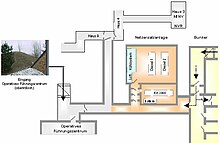Operational command center of the Ministry of National Defense
The operational command center of the Ministry of National Defense (OFZ) was the central management body on duty at the head of the main staff of the National People's Army (NVA) of the GDR .
The facility in Strausberg was planned on the basis of requests from the Chief of Staff on October 5, 1979 for a further increase in leadership in the NVA, its construction was prepared and put into service with the functional test in autumn 1980. It was a two consecutively made aircraft shelters crafted shelter with soil cover, were set up in the two-storey service and working spaces. The OFZ's intelligence backup was carried out by the main intelligence center of the Ministry of National Defense .
The basic starting point for its establishment was the creation of a central duty facility in the MfNV to support the management activities of the Minister for National Defense and his deputies under the conditions of daily duty and to ensure the planned transition of the MfNV to a higher level of combat readiness and to fulfill its tasks special location conditions. In the mid-1980s, the "Schnur" alerting system was introduced from the USSR and installed in the Operational Command Center.
His task was to constantly manage the operational situation with the enemy, especially the NATO armed forces in the command areas of Central Europe and Baltic Sea exits, as well as with his own troops and naval forces and on the territory of the GDR, and to maintain such a service regime that the rapid reaction to fundamental changes in the situation. In the case of special situation developments inside and outside the territory of the GDR, as well as in the case of military actions in war zones around the world, the necessary data was collected, evaluated and processed for the ministers of national defense or the party and state leadership.
The management task consisted of:
- the ongoing management and assessment of the situation of the NATO armed forces in Central Europe, as well as the situation on the inner-German border and the border with West Berlin ,
- the daily management of the situation and condition of the troops and fleet forces as well as the facilities of the NVA, the border troops of the GDR and the situation on the territory of the GDR,
- the preparation, summary and analysis of reports,
- ensuring the alarm and notification via the alarm systems Monument of the staff of the United Armed Forces and cord of the NVA,
- the guarantee of the leadership of the NVA, the border troops and the civil defense of the GDR during the transition to higher levels of combat readiness after the work of the operational command group has been established up to the establishment of the command readiness of the main command post, and others.
The workforce in the OFZ was made up of a structural group and a temporary group; a total of 17 to 22 members of the army were on duty in daily service and 30 to 40 members of the army in times of stress.
The OFZ was connected via an underground corridor to the "Vostok" message center and the basement rooms in buildings 9 and 4, which were developed as an alternative control point for MfNV K 23/24 , to the rooms of the National Defense Council in building 3 of the MfNV. Outside the home, the written information exchange between the facilities took place via a pneumatic tube control center .
photos
- Operational management center
literature
- Joachim Kampe: Wostok - the news center in the center of the military power of the GDR , ISBN 3-932566-60-2
- Hans-Werner Deim, Hans-Georg Kampe, Joachim Kampe, Wolfgang Schubert: The military security of the GDR in the Cold War , ISBN 978-3-932566-80-6
Web links
- Main news center homepage
- Subterranea Britanica: Pictures by Nick Catford (English)
- The operational management center of the MfNV
- Operational leadership center / video
Coordinates: 52 ° 35 ′ 31.6 ″ N , 13 ° 55 ′ 19 ″ E





